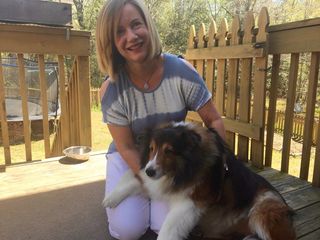Meditation
How an App Helped Me Cope with the Death of My Beloved Dog
How high tech can mean high touch
Posted April 18, 2019

I have just lost one of the loves of my life: my 12-year old Shetland Sheepdog, Gracie. Because Gracie had been elderly and infirm for a while now, I had been dreading losing her. She had arthritis. She was almost deaf. It was hard for her to get around. I knew her days were numbered, but I allowed myself to hope that I’d have longer with her than I ended up having.
Gracie was a sweet soul through and through. And she was a gorgeous girl. When she was young, she would bound off of the back porch and fly through the air like one of Santa’s reindeer. When she was old and her body was giving out, she would sit in the window of my office, with her chin resting on the windowsill, looking outside and “sniffing the sniffs,” as I used to call it. She’d only get animated when the UPS man would arrive; then she would bark with all the energy of a dog doing her job: protecting the family.
I won’t take you through all of the heart-wrenching details of how we lost her. I know many of you have lost a dog, cat or other pet. But when it happened I was thoroughly taken over with grief. I cried that kind of deep, miserable cry where you can’t catch your breath. I looked to the sky and said, “NO!” I didn’t see how I could possibly bear this pain. The sobbing turned into walking around the house with tears constantly streaming down my face, walking as if in a stupor, going from window to window wondering where Gracie was.
Facing the Grief of Losing a Pet
I knew that if I did not face this grief head on, it would get the best of me. I did a number of things: I spent time with friends, I talked about Gracie and about her loss, I volunteered. My mom always says that when you are sad or down, the remedy is to go out and help others. So, I did that and it helped immensely.
I also did something else that helped me in ways I don’t think I could have dreamed were possible. I opened up one of my favorite apps and I used it in a way that I thought would be the best for my own recovery.

Don’t Hang Up
I am a long-time meditator. I use a meditation app called 10% Happier. Now, wait, if you’re not a meditator, please don’t just stop reading. Here’s why: I think people sometimes don’t understand all of the different things that meditation can be and do for you. So, give me a minute to explain before you totally write it off as something that could't help you.
10 Percent Solution
The 10% Happier app brings together a large selection of experts on meditation for you to chose from. The experts give talks about how to understand and use the techniques they are offering. There are a wide variety of experts and approaches, so there’s something for everyone. Inside the app, you can choose a topic (sleep, stress, difficult emotions, focus). You can also choose an expert. If you want more, there are the books and the free podcast that’s available. To explore the options, start here: https://www.10percenthappier.com/
10% Happier began with ABC News Anchor, Dan Harris, who had a panic attack on the air. He then wrote the book 10% Happier, based on the premise that these techniques could improve your life by making you—you got it—10% happier. Later, Dan wrote the book Meditation for Fidgety Skeptics. (Click here for an introduction to the approach.)
What Helped and How
I’m going to give you a list of some of the tracks on the app that I used that helped me, and then tell you why and how they helped. Each of these starts with a video interview between the teacher and Dan Harris.
It’s Okay to Feel This/Joseph Goldstein
You have to fully feel your difficult emotions to get past them. It’s a paradox, but it’s an unavoidable truth. Think of it as either ripping off the Band-Aid or slowly pulling it off. The good news is that if you look at your pain full on, it might heal much more quickly.
Find Your Resilience/Jay Michaelson
This meditation also asks you to identify and even intensify your feelings about something in your life that is challenging. It also specifically addresses the fears that you have about the situation and the story that you’re telling yourself about the situation. In the end, it teaches you that difficult situations will continue to happen, but you’ll be there armed with the skills you have practiced.
Joy/Sebene Selassie
Sebene starts this meditation telling the story of how she found joy even in sitting beside her mother who was on her death bed. That’s because as she says, joy is not happiness. It’s something more grounded.
Open Monitoring/Dave Vago
I think of the technique of open monitoring more like a brain game than a traditional meditation. Dave Vago is a neuroscientist and open monitoring is an attentional strategy that brings you into the moment. It works for me to do this one while driving. Don’t worry, it’s safe because I am paying MORE attention to what’s around me than usual, not less.
These are the specific meditations I “prescribed” for myself during my period of most intense loss and suffering. At the end of this blog, I’ll list some more than helped me build my skills beforehand.
The Results
I know that practicing meditation like this helps make my mind stronger. But I was completely surprised by how strong this treatment was. I have lost other pets and been devastated by it. Given how close Gracie and I were, I didn’t think anything was possible other than my continuing to suffer for a long, long time in a sharp and persistent way. Using these training sessions was a game changer. They guided me in their very different ways to be present with the pain. In actively choosing to feel my deep grief, it almost magically lessened the suffering outside of that practice.
Dealing with the death of a loved one is a complex and varied process. Something that feels right to one person may feel wrong to another. My go-to perspective on dealing with life is that I make a conscious choice to do the healthiest thing I can imagine in any given situation. Facing the grief and using meditation was what occurred to me as the healthiest thing I could do, coupled with the other strategies I listed above (like talking with friends and helping others).

On Humans and Technology
People have a habit of thinking of media and technology as almost anti-human. If I said I used an app to help me grieve, to some, that would sound cold and robotic. But the truth is that technologies aren’t automatically inhuman. This app helps me connect with some of the world’s greatest meditation teachers -- a.k.a. real people. Those human beings talked to me and lead me through practices that gave me actual relief from my pain. I wasn’t escaping or distracting myself. I was taking the hand of each guru who lead me through the darkness back to the light.
Another technology that helped me cope was social media. I posted throughout Gracie’s ordeal. Friends sent me words of encouragement. They also messaged me, texted me and called me. These are ways people used media as an extension of themselves to express their humanity.
The techniques I talked about here may not work for you. Something else may be right. Or something that works one day may be less helpful another day. There are no easy answers when it comes to coping with loss.
I still miss Gracie. I still wish she were here with me, sitting in the window, watching for the UPS man while I write this blog. She was there for so many of the other ones. Nothing can entirely take the pain away, nor should it, maybe. But the skills I’ve learned and the techniques I use for coping allow me to see the experience more clearly. This process has allowed me to learn things about living and dying and loving that I might not be able to see if my mind weren’t clear enough for them to register.
I’m grateful for all the ways, technological and otherwise, that I walked through the first part of my journey with grief. I expect that there will still be bad days.
I’m grateful that technology helps me reach out to other people. I hope that sharing my experiences and the tools I used might help you, if even just a little.
Namaste
Other 10% Happier courses/meditations that have helped me:
Is worrying useful? by Dan Harris
A New Day by Alexis Santos
We Believe What We Think and No Me at the Center by Anushka Fernandapulle
The Truth of Change by Sharon Salzberg
Simply Staying Open, The Reset, Making Space, Your Phone, Sleep River, Power Down, Rage Relief, Welcome to the Party, and my daughter’s favorite, Wearing Pants, all by Jeff Warren




